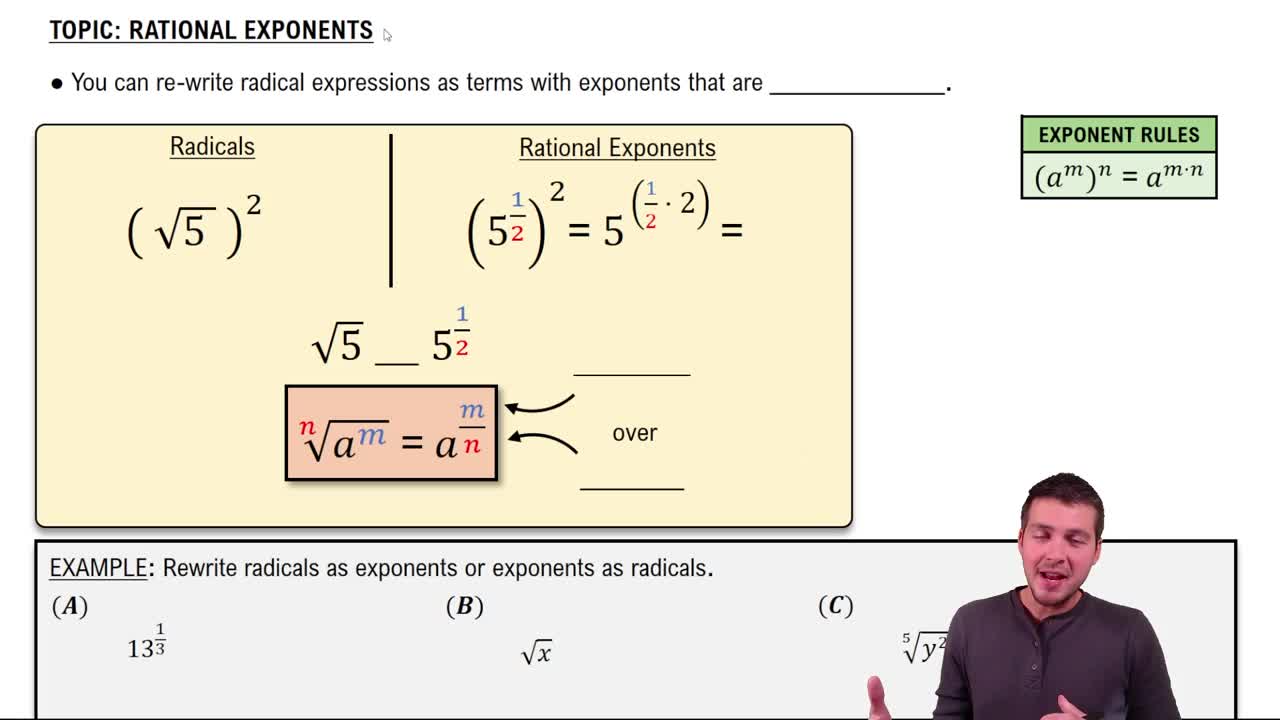Table of contents
- 0. Review of Algebra4h 16m
- 1. Equations & Inequalities3h 18m
- 2. Graphs of Equations43m
- 3. Functions2h 17m
- 4. Polynomial Functions1h 44m
- 5. Rational Functions1h 23m
- 6. Exponential & Logarithmic Functions2h 28m
- 7. Systems of Equations & Matrices4h 6m
- 8. Conic Sections2h 23m
- 9. Sequences, Series, & Induction1h 19m
- 10. Combinatorics & Probability1h 45m
9. Sequences, Series, & Induction
Sequences
Problem 33b
Textbook Question
In Exercises 25–34, use mathematical induction to prove that each statement is true for every positive integer n. (ab)^n = a^n b^n
 Verified step by step guidance
Verified step by step guidance1
Step 1: **Base Case** - Verify the statement for the initial value, usually n=1. Check if \((ab)^1 = a^1 b^1\).
Step 2: **Inductive Hypothesis** - Assume the statement is true for some positive integer k, i.e., \((ab)^k = a^k b^k\).
Step 3: **Inductive Step** - Prove the statement for n=k+1 using the inductive hypothesis. Start with \((ab)^{k+1} = (ab)^k \cdot (ab)\).
Step 4: Substitute the inductive hypothesis into the expression: \((ab)^k \cdot (ab) = (a^k b^k) \cdot (ab)\).
Step 5: Simplify the expression to show \((a^k b^k) \cdot (ab) = a^{k+1} b^{k+1}\), thus proving the statement for n=k+1.
Recommended similar problem, with video answer:
 Verified Solution
Verified SolutionThis video solution was recommended by our tutors as helpful for the problem above
Video duration:
5mPlay a video:
Was this helpful?
Key Concepts
Here are the essential concepts you must grasp in order to answer the question correctly.
Mathematical Induction
Mathematical induction is a proof technique used to establish the truth of an infinite number of statements, typically involving positive integers. It consists of two main steps: the base case, where the statement is verified for the initial value (usually n=1), and the inductive step, where one assumes the statement holds for n=k and then proves it for n=k+1. This method is essential for proving statements that are defined recursively or involve sequences.
Recommended video:
Guided course

Types of Slope
Properties of Exponents
The properties of exponents are rules that govern how to manipulate expressions involving powers. Key properties include the product of powers (a^m * a^n = a^(m+n)), the power of a power ( (a^m)^n = a^(m*n)), and the power of a product ( (ab)^n = a^n * b^n). Understanding these properties is crucial for simplifying expressions and proving identities involving exponents.
Recommended video:
Guided course

Rational Exponents
Base Case and Inductive Step
In mathematical induction, the base case is the initial step that verifies the statement for the smallest integer, usually n=1. The inductive step involves assuming the statement is true for an arbitrary positive integer n=k and then demonstrating that it must also be true for n=k+1. This two-part structure is fundamental to the induction process, ensuring that if the base case holds, the truth of the statement can be extended to all positive integers.
Recommended video:

Change of Base Property

 8:22m
8:22mWatch next
Master Introduction to Sequences with a bite sized video explanation from Patrick Ford
Start learningRelated Videos
Related Practice








